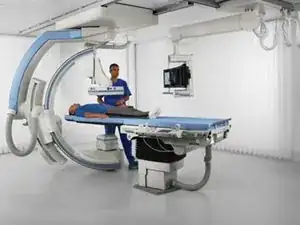Background and Identification
OEC machines, which are also known as C-arms, are used in the medical industry to produce images of internal areas of the body using radiography. Radiography is an imaging technique using X-rays, gamma rays, or other similar ionizing radiation and non-ionizing radiation to view the internal form of an object. Radiography applications include diagnostic and therapeutic medical radiography, industrial radiography, and airport security. In medical applications, ionizing and non-ionizing radiation can be used to show the internal structure of a body on an image receptor.
During emergency care situations where access to digital radiography X-ray machines may be limited, OEC C-arms can be used as fluoroscopic systems. OEC C-arms are designed to provide fluoroscopic and digital spot images during diagnostic, interventional, and surgical procedures. Fluoroscopy is an imaging technique that uses X-rays to produce real-time moving images of the interior of an object or body. Fluoroscopes are primarily used in medical imaging and allow physicians to see the internal structure of a patient. Fluoroscopes allow doctors to see things like the pumping action of the heart or the motion of swallowing. This is useful for diagnosis and therapy and is used in general radiology, interventional radiology, and image-guided surgery.
G-arm medical imaging systems are similar to C-arm systems, but G-arm systems combine a pair of X-ray chains allowing for simultaneous views in two perpendicular planes.
GE OEC C-arm machines can generally be identified by the GE emblem, which includes the letters “GE” in cursive font inside of a circle. GE OEC C-arm machines generally include a flat surface on which the patient lies and a machine with upper and lower arms that form a 'C' shape and scan the patient.

